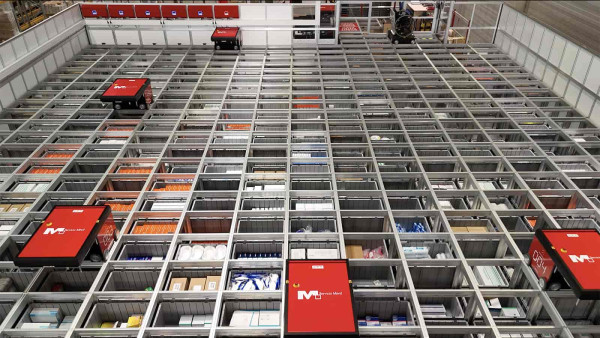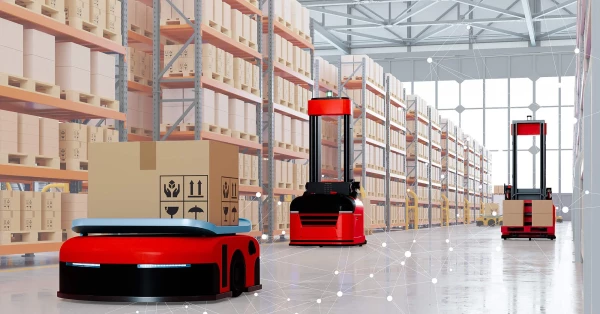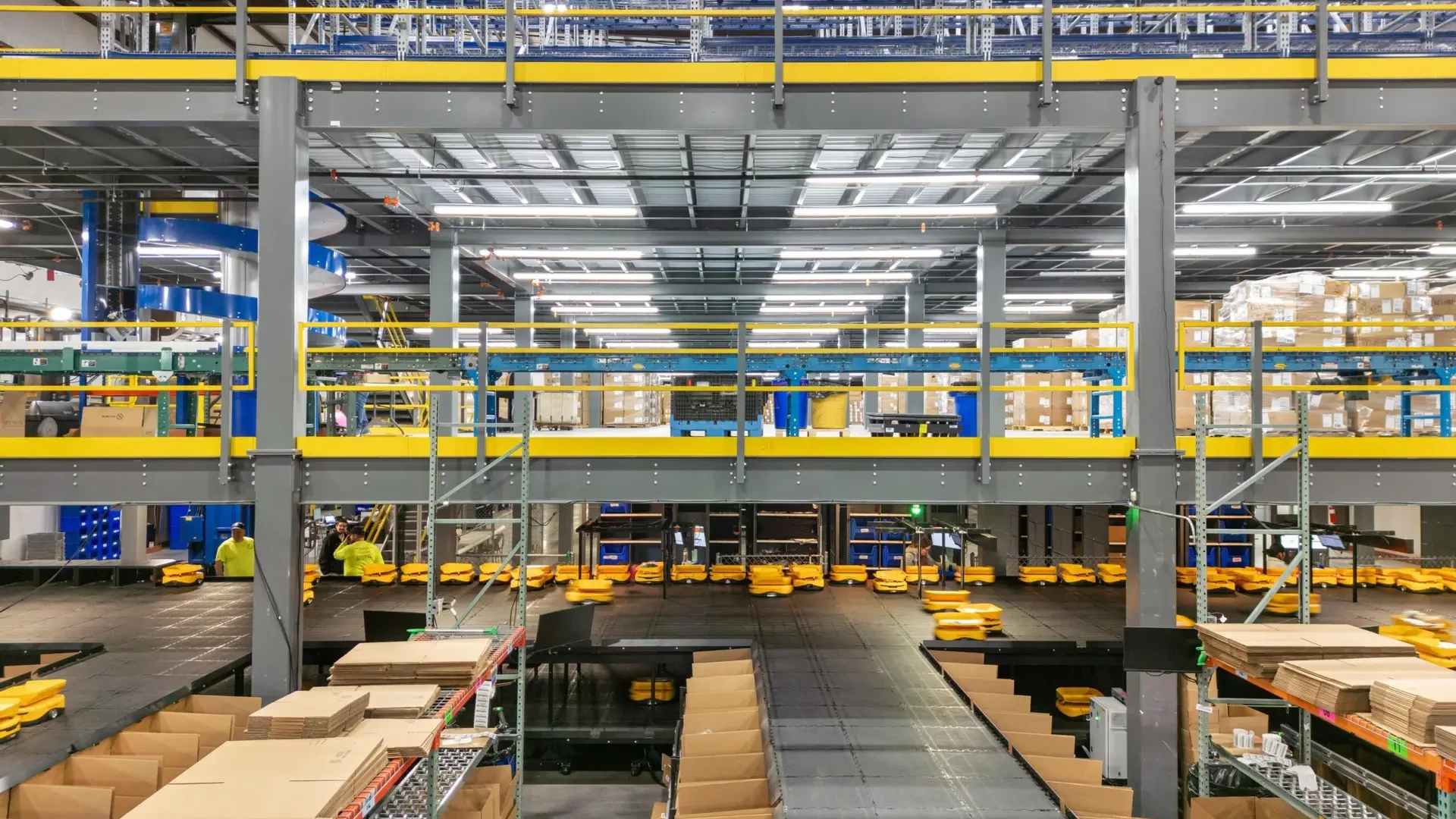Warehouses are under pressure like never before—mounting customer demands, tighter margins and an insatiable need for speed. But which automation path should you take when faced with choices like Automated Storage and Retrieval Systems (AS/RS) or Automated Guided Vehicles (AGVs)? Both play critical roles in streamlining material handling systems and automated logistics, so it’s no wonder they’re among the most popular choices.
This article examines the key differences between AS/RS and AGVs, providing valuable insights for warehouse managers, logistics professionals, and supply chain experts looking to enhance operational efficiency. By measuring these systems head-to-head, we aim to help you choose the most suitable warehouse automation solution based on your unique requirements.
Overview of AS/RS
What are AS/RS?
Automated Storage and Retrieval Systems (AS/RS) are sophisticated material handling solutions designed to manage, store and retrieve inventory with minimal manual intervention. They typically comprise cranes, vertical lift modules, carousels, and shuttles, all directed by a centralised control system. By automating the storage process, AS/RS helps warehouses handle higher SKU counts while maximising vertical space.
Benefits of AS/RS
-
Optimal use of space: AS/RS leverages vertical and compact racking systems to store items in high-density configurations.
-
Precision picking: Automation significantly lowers picking errors, boosting inventory accuracy and reducing the risk of product damage.
-
Increased throughput: Rapid retrieval speeds allow warehouses to handle larger volumes of orders efficiently.
-
Safety improvements: By reducing manual handling, AS/RS minimises workplace injuries and fatigue.
These benefits collectively make AS/RS highly attractive for businesses that need robust, precise and high-volume inventory handling. By minimising manual intervention, AS/RS ensures consistency, lowers labour costs, and supports stringent quality standards.
Ideal use cases
AS/RS is particularly beneficial in environments with vast SKU ranges or where inventory control is imperative, such as pharmaceutical or electronics warehouses requiring stringent stock management. In facilities handling high-value or fragile products, AS/RS can help safeguard items from mishandling. Additionally, businesses experiencing rapid growth or those operating around the clock can deploy AS/RS to increase throughput while maintaining accuracy, even during peak demand.

Overview of AGVs
What are AGVs?
Automated Guided Vehicles (AGVs) are driverless transport units programmed to move materials and products around a warehouse or manufacturing facility. They typically navigate using embedded wires, magnetic strips, or laser guidance systems, allowing them to follow predetermined routes safely. Common types include tow vehicles, forklift AGVs, and unit load carriers. AGVs excel at repetitive transport tasks, reducing manual labour and improving operational consistency across multiple warehouse zones.
Benefits of AGVs
-
Flexibility: AGVs can be reprogrammed and rerouted if your warehouse layout or processes change, making them versatile in evolving environments.
-
Cost-effective deployment: Compared to fixed automation solutions, AGVs often require fewer structural modifications, leading to reduced initial investment.
-
Improved safety: Advanced sensors and collision avoidance software help minimise accidents, safeguarding workers and products.
-
Scalable operations: You can add or remove AGVs based on demand, allowing your material handling capacity to adapt to seasonal peaks.
Consequently, AGVs enable businesses to streamline internal logistics while maintaining the flexibility to respond to shifting operational needs.
Ideal use cases
For a mezzanine warehouse that handles varied picking routes or changes their floor layout frequently, AGVs offer a dynamic transport solution. Industries like automotive, retail distribution, and e-commerce often rely on AGVs to ferry items between staging areas and dispatch zones. Additionally, operations involving just-in-time manufacturing processes benefit from AGVs’ capacity to deliver components accurately and promptly to assembly lines.

Comparing AS/RS and AGVs
Key differences
While both Automated Storage and Retrieval Systems and Automated Guided Vehicles fall under warehouse automation technology, they perform distinct functions. AS/RS primarily manages item storage in fixed, high-density racking, leveraging vertical space for efficient inventory control. By contrast, AGVs handle horizontal transport, moving products to various points within the facility. Speed is another differentiator: AS/RS provides rapid, precise retrieval, whereas AGVs focus on flexible movement across different zones. Additionally, AS/RS installations often require substantial infrastructure, while AGVs can generally be integrated with fewer structural modifications.
Costs and ROI
Implementing AS/RS can demand a higher upfront investment, particularly for infrastructure and advanced automation components. However, the potential return on investment can be significant if your operation needs high-speed picking and minimal errors. AGVs, on the other hand, may offer lower initial costs and quicker deployment. Ultimately, ROI depends on factors like warehouse size, operational complexity, throughput requirements, and long-term strategic objectives.
Capacity to scale and adapt
As businesses grow, their material handling needs may shift. While AS/RS can be expanded, doing so often requires structural adjustments. AGVs offer more agile scalability; adding extra vehicles can immediately boost transport capacity. If your warehouse experiences frequent layout changes or fluctuations in order volume, AGVs can help you quickly adapt without extensive redesign.
How to choose the right automation solution
Selecting between AS/RS and AGVs depends on multiple variables:
-
Operational requirements: Determine your order volume, SKU diversity, and handling frequency.
-
Space constraints: Evaluate whether vertical storage (AS/RS) or flexible floor movement (AGVs) better suits your facility.
-
Future growth: Anticipate scalability needs and the likelihood of layout changes.
-
ROI expectations: Estimate budget, implementation timelines, and labour cost reductions.
Lastly, consult experienced providers like Unistor to tailor a system that aligns with your operational goals. Our expertise ensures you gain a solution that seamlessly integrates with Warehouse Management Systems and fosters long-term efficiency.
Conclusion
Tossing up between AS/RS and AGVs can be challenging, but making an informed decision is crucial for staying competitive in an evolving marketplace. Consider the nature of your inventory, space availability, future expansion plans, and overall operational objectives. Whether you opt for the precision of AS/RS or the flexibility of AGVs, partnering with experienced solution providers like Unistor ensures you maximise efficiency and maintain high service levels.
For tailored advice and to learn more about our warehouse automation and industrial mezzanine solutions, speak to our team of experts at Unistor. With thorough planning and the right guidance, you can implement a system that best suits your material handling requirements, reduces operational costs, and accelerates order fulfilment. Position your business for future success, today.



